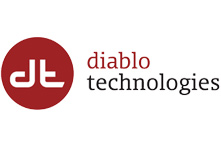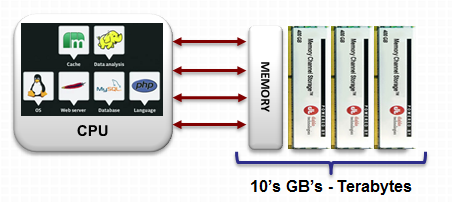 Diablo Technologies, MCS Tech specs by CEO Riccardo Badalone
Diablo Technologies, MCS Tech specs by CEO Riccardo Badalone
Date: 10 September 2014
Diablo Technologies Crunchbase Profile
Following the first part of the interview with Riccardo Badalone, this article goes further into the background of Diablo MCS and the performance it delivers.
Diablo’s Road to MCS
Diablo Technologies has been strong in the memory subsystem. From 2003 onwards, the company has always been in the space between the processor and the memory. Essentially creating a layer of abstraction between the physical interface and the logical interface the processor thinks it is communicating with.
The first development focused on analog IP for high speed serial interconnect. In 2005 Diablo built on top of that with the first product being a bridging product in x86 for fully buffered Dimms; Low power bridges with interface of the processor on one side, interface of DRAM on the other. It was an primarily a physical layer device, no software component. In 2008 the company pivoted, focused purely on flash and non-volatile media. Diablo sought a way out of the DRAM space, while leveraging the expertise and know-how in the memory subsystems.
Diablo MCS Technology
In 2008 Diablo started on the architecture of MCS, in essence a software stack & protocol stack plus physical layer, that allows you to essentially create the heterogeneous environment of DRAM plus NAND flash within the memory pool of the processor. The CPUs can only talk to what it thinks is DRAM, Diablo allowed other media (like flash) into that memory subsystem. While the processor has only one interface, it can logically communicate with several types of media.
MCS is not specifically tied to flash, however the first product Diablo is introducing to the market with SanDisk UltraDimm, is essentially a flash product.
The value of this technology is leveraged by Diablo’s software development that built driver interfaces that allows Linux, Windows and VMware hosts to create i/o streams. Data can move seamlessly from the non-persistent to the persistent storage. This leads to lots of latency being trimmed out of the system, and creating high bandwidth and throughput.
As covered in my earlier article, Diablo MCS are 200GB / 400GB / soon 1TB NAND flash modules that are designed to connect directly to the memory bus. The product looks like a regular DDR3 RAM module, while featuring persistent NAND flash. MCS modules are plugged right in the memory slots and can be configured to be recognised as Storage or Memory. Diablo requires one DIMM slot to be occupied by a regular DDR3 module. Additionally, to overcome the higher latency of NAND vs DRAM, the MCS modules themselves have a DRAM buffer.
Latency and Throughput
MCS is able to deliver very high performance, making use of low-cost, standard 19 nm MLC NAND flash. The write latency for 4k single thread, low queue-depth writes is in the order of 4μs to 5μs, compared to typical 20-25μs latency for a PCIE device. Riccardo explains that the biggest advantage of MCS is that it has a very flat latency across a large variety of blocksizes at a queue depth of one. By splitting larger blocks and writing in parallel across 8 channels, the latency for 16k or 64k persistent writes are the same latency of around 5μs.
Riccardo stresses that they have not optimized for single writes, and that their technology really shines in the high throughput that can be sustained with low latency. He insists that in most test results that competitors are showing, throughput and latencies are disconnected. According to him, MCS is able to supply 2.5 GB/s sustained write throughput at 20μs latency and 1.5 GB/s sustained write throughput at 10μs latency.
Similarly, read latency is not optimized for single reads. Latency for a 4k read is in the order of 110 μs, however scaled up to 512 or 1024 reads the latency will only go up to 180μs. This gives a read throughput of 4 GB/s per second with a latency of 180μs.
Current status and future plans
Diablo has plans for subsequent products, but is now focused on MCS which is currently being deployed. Presence in the US and Europe is building, with a current staff of 75 employees. Aside from dedicating resources on software development and R&D, Diablo has much focus on solution engineering; attracting solution architects that architect the specific ways in which customers can leverage the technology for various applications and use cases.
Background and links
Interview Riccardo Badalone – CEO Diablo Technologies – Views on storage market
In depth article by Joel Hruska / Extremetech
The official website of Diablo Technologies
The official website of Smart Storage Systems

Geef een reactie